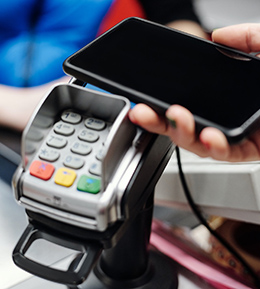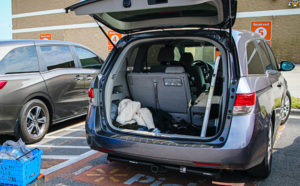The Future of Retail: Is Your Store Ready?
I have seen the future and it is very much like the present, only longer.
The future ain’t what it used to be.
Yogi was right, especially in the world of brick-and-mortar retail. Once upon a time, the future of retail was filled with interactive customer experiences. Hands-on, real touchy–feely stuff. COVID-19 changed a lot of that.
 While customers are still looking for personalized shopping experiences, touchless has become the immediate future of retail. Online shopping with either buy online, pick up in-store (BOPIS also known as curbside pickup) or same-day or next-day delivery are the options consumers are choosing. Touchless in-store payments are also still trending. As long as COVID-19 is with us, and many say well after the virus dissipates, those shopping trends will continue.
While customers are still looking for personalized shopping experiences, touchless has become the immediate future of retail. Online shopping with either buy online, pick up in-store (BOPIS also known as curbside pickup) or same-day or next-day delivery are the options consumers are choosing. Touchless in-store payments are also still trending. As long as COVID-19 is with us, and many say well after the virus dissipates, those shopping trends will continue.
Data from Adobe Analytics for August 2020 shows online sales increased 42% over the previous year. That followed a July that saw a 55% increase over 2019 figures. The report also shows there were 130 days on which online shopping topped $2 billion and three days when sales hit $3 billion.
The Adobe study also indicated the trend of consumers using curbside pickup – orders placed online and picked up at stores – increased 259% year-over-year. So, stores with omnichannel capabilities – technology that combines online and in-store marketing, sales, and fulfillment – will be better equipped to succeed in the new year.
“Consumers expect more from merchants today. Due in part to the evolution of retail, which now offers more personalized choices from e-commerce companies, shoppers want similar features from their neighborhood stores,” says Dan Nesmith, president of Paladin Data Corporation, a leader in retail management technology. “Stores need to embrace new ideas and all technology offers. Merchants need to create a strong and cohesive digital image for their stores including automated customer satisfaction surveys, mobile-friendly e-commerce customer portals, digital advertising, and strong, secure in-store Wi-Fi.”
It is far better to foresee even without certainty than not to foresee at all.
Those lucky enough to be properly equipped could still work thanks to remote access to their business networks. Mobile access and remote capabilities kept many retail businesses open and functioning. Many stores without those abilities had no way of doing business when their doors closed, and they failed.
It used to require a roadmap for travelers to find the way to their destinations. Nowadays, GPS online applications can find almost any place in the world. Just Google your destination and ask for directions and you’ll get multiple options.
The omnichannel technology that became so necessary to stores during the pandemic shutdown will continue to offer businesses and shoppers multiple options and will be critical to success. Mobile and remote access, touchless and alternative payment methods, complete business management from a single desktop terminal or laptop will become commonplace in successful stores.
Those who have knowledge, don’t predict. Those who predict, don’t have knowledge.
Some think Nostradamus, who died in 1566, somehow foresaw the current coronavirus pandemic. Predicting the behavior of consumer response and the future of retail in the wake of it doesn’t seem to be that incredible. Retail and economic experts believe that many people will continue practicing the shopping habits they learned during the shutdown.
Online shopping – In September 2020, U.S. online sales was roughly $60.4 billion, a 43% increase over 2019. August’s year-over-year increase was 42%. That is expected to continue. CommerceHub, a software provider, surveyed more than 2,000 U.S. consumers to get a feel for future shopping patterns. The survey found that 67% feel it’s more convenient to shop online than in store, and 89% plan to continue the practice.
A rapidly increasing number of online searches are voice searches. Thanks to Google, Amazon’s Alexa, Apple’s Siri and Microsoft’s Cortana, almost half of online searches are made with voice commands. Adobe Analytics says that 30% of home voice searches are used for ordering and shopping. That means if your products aren’t online and available to such searches, you could be missing out on a lot of sales.

Curbside pickup – During the height of store closures, shoppers turned to programs like buy online, pick up in-store (BOPIS) to purchase their goods. The CommerceHub study shows that 67% of consumers indicated they will continue to do so. Approximately 53% of retailers expect programs like BOPIS to grow in popularity.
Fulfillment options will continue to grow as well. Big-box stores and e-commerce companies are on the verge of delivering orders with rolling robots and flying drones which they say will increase speed and efficiency.
Touchless or low contact options – A National Retail Federation survey of retailers in August 2020 found that 67% accepted some form of touchless payments. It also found that 58% took contactless cards which was a 40% increase from 2019. An incredible 94% of them said they anticipate the trend to continue over the next 18 months.
There’s no present. There’s only the immediate future and the recent past.
Updating store technology is one of the quickest ways to step into the future of retail. E-commerce has grown steadily for the past 20 years. The pandemic kicked that growth into warp speed. Businesses that adapted succeeded. Those that didn’t closed or struggled to reopen. Retail technology not only allows stores to sell online when their physical doors are closed, it:
- Streamlines routine processes such as inventory, bookkeeping, workforce management, customer outreach and incentives
- Builds customer confidence and loyalty with more efficient low- or no-contact service, offers payment options, and heightens the shopping experience
- Improves store, customer and shopper safety, convenience and accessibility
- Empowers employees to deliver enhanced customer service through a variety of channels
- Offers mobile and remote capabilities that allow business to be done away from the checkout counter and enables network access from almost anywhere
To steal from George Carlin, preparing for the immediate future of retail is really just looking at the recent past and adjusting to what is working. It’s a lot like planning for the long-term success of a business, only faster. Using technology to create omnichannel online and in-store sales, services and business management will help keep cash registers ringing in the new year.
brian bullock
Author


